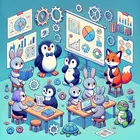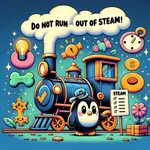Practices
Explore proven practical strategies that have helped others.
Similarly to concepts, sharing practices with people helps to create a shared understanding. It can be helpful to groups to refer to practices by their name, enabling more efficient communication.
However, without a clear description of their meaning, the use of jargon can cause confusion and misunderstandings.
To help you find practices that support you in your particular challenges, each practice contains a description of the context in which you can
use it. This context is described as enablers and deterrents, these indicate under which conditions the described pattern is known to work
well, and conversely when it doesn’t work well. To get the best results, pay attention to these factors when reading the patterns below.
Each of the patterns is accompanied by a set of tags and categories, these help you find related learning resources, practices and concepts.
Additionally, each pattern has been scored on the different aspects of the AMMERSE framework. This value-based
assessment aims to clarify the impact of the pattern on different aspects of your work and life.
When implementing the techniques listed here, regularly reflect on the effectiveness of the technique and make adjustments as needed to avoid
stress and maintain a positive flow without compromising your quality of life.
To stay up to date with the latest additions to these practices, subscribe to the RSS feed in your
favourite feed reader.
Build your knowledge portfolio
Take stock, Evaluate, and Invest wisely.
problem:Knowledge workers often struggle to effectively allocate their learning efforts, leading to underutilised skills, outdated knowledge, and missed opportunities for growth.
description:Apply a structured approach for regularly assessing and balancing personal knowledge portfolios, enabling informed decisions on where to invest time and effort for maximum growth.
Mind Mapping
Organize your thoughts and knowledge visually
problem:You are learning a wealth of new information, but find it difficult to keep an overview of what you know.
description:Mind mapping is a technique that helps you visually organize and structure your thoughts, enhancing your ability to understand, connect, and retain knowledge.
problem:You have an idea and want to strengthen it against negative forces.
description:Proactively challenge your ideas by identifying potential failure points, prioritizing them by impact, and developing strategies to mitigate the most critical risks, thereby strengthening your ideas against unforeseen challenges.
problem:You have troubles learning new skills or techniques, as you are afraid it will be more trouble than it's worth.
description:Reframe learning as a series of experiments to reduce the fear of failure, accelerate skill development, and enhance knowledge sharing.
problem:Inefficient training practices cause poor knowledge retention and inconsistent skill development across the organization.
description:Standardize the process of knowledge transfer within organizations to break down silos, ensuring that critical information is effectively distributed and consistently delivered.
Value-based Impact Analysis
an AMMERSE-based Impact Analysis Algorithm
problem:You want to ensure balanced and well-informed decision-making that aligns with desired (organizational) core values.
description:Apply an AMMERSE-based analysis to evaluate the likely impact of decisions, practices, and techniques on the system under change.
Wax on, wax off
Practice, Rinse, Repeat. Then practice some more.
problem:You find it hard to apply a new skill or idea in your daily life.
description:Establish a routine of repeatable exercises to master new skills and make techniques second nature through consistent practice.
Write a 'Manual of Me'
Document your habits, communication preferences, and quirks
problem:Working with different people is challenging. Not every context is right for you, and not every person is easy to work with. Finding a way to collaborate effectively requires understanding your own preferences, and those of others. However, these preferences are often implicit, leading to misunderstanding and conflict.
description:The Manual of Me is a lightweight, self-authored guide to your preferred working style, communication habits, and values. It’s a reflection tool first, and optionally, a shared resource to help others understand how best to collaborate with you.
10 Minute Tasks
Reclaiming wasted moments
problem:There are not enough hours in a day, you have many small tasks that you never get around to doing.
description:Reclaim otherwise wasted moments by using them to complete small, useful tasks.
problem:You often struggle with deciding what to do next, feeling uncertain about which choice would be most beneficial for you.
description:Use a systematic framework to make informed decisions by evaluating your resources — Support, Time, Energy, Attention, and Money.
problem:You find yourself constantly busy, yet achieving little of value.
description:Assign a priority category to tasks based on their urgency and importance. Act depending on priority category.
problem:You find it difficult to remember what you want to achieve, and are distraught by the amount of tasks you have yet to finish.
description:Apply a personalized approach to productivity, helping you offload and organize tasks and ideas using a trusted system, ultimately reducing mental stress and enhancing focus.
problem:You are distracted by various inputs from your environment, causing you to not finish tasks you set out to do.
description:The Pomodoro technique helps you stay focused and productive by breaking tasks into manageable time intervals with regular breaks, making it easier to accomplish your goals.
problem:You tend to push too hard trying to reach a goal, or invest more than you can support.
description:Put a hard limit on how much you are willing to invest into a certain endeavour.
The OPERAs method
Orientate, Prepare, Execute, Reflect, Adapt, Synthesize
problem:How do you make structured progress towards a specific overarching goal?
description:The OPERAS mental model provides a structured, adaptable process for advancing tasks and goals from planning to completion, ensuring progress and learning at every step.
problem:You want to reduce the impact of being pulled out of your flow.
description:Delegate memory tasks to an external system to reduce cognitive load, maintain focus, and improve task management.
problem:You are accumulating invisible baggage: paused tasks, lingering ideas, and false progress signals.
description:Reset of your work-in-progress every day. Recommit only to what truly matters, and shelve the rest without feeling guilty.
problem:Someone disagrees with you, and you have difficulties understanding why
description:Employ a method for identifying the root cause of disagreements by breaking down arguments into premises and consequences, promoting understanding and constructive dialogue.
Impact-Oriented Communication
Quantify your story, increase your clarity
problem:Technical professionals often describe tasks, tools, or deliverables without articulating the outcome.
description:Avoid invisibility by describing your work in terms of measurable outcomes that align with team and organisational goals.
problem:Assessing a candidate's skills and experience during an interview using traditional knowledge-based questions often leads to researched and rehearsed answers.
description:Employ a behavioural questioning method, to conduct more conversational interviews, and enticing candid and truthful responses.
Listening to Understand
The LARS Technique for Improved Conversations
problem:You have difficulties connecting with others, and find yourself disengaged during conversations.
description:Shift from responding to truly comprehending what the other person is saying, leading to more meaningful interactions.
problem:Inefficient training practices cause poor knowledge retention and inconsistent skill development across the organization.
description:Standardize the process of knowledge transfer within organizations to break down silos, ensuring that critical information is effectively distributed and consistently delivered.
problem:Technical and complex communication often fails to engage or resonate with its intended audience, either by assuming too much prior knowledge, oversimplifying concepts, or lacking a clear connection to the reader’s real-world challenges.
description:A technique to help technical writers structure content for different reader groups by adapting tone, depth, and complexity or splitting content when necessary.
Write a 'Manual of Me'
Document your habits, communication preferences, and quirks
problem:Working with different people is challenging. Not every context is right for you, and not every person is easy to work with. Finding a way to collaborate effectively requires understanding your own preferences, and those of others. However, these preferences are often implicit, leading to misunderstanding and conflict.
description:The Manual of Me is a lightweight, self-authored guide to your preferred working style, communication habits, and values. It’s a reflection tool first, and optionally, a shared resource to help others understand how best to collaborate with you.
problem:People tend to wait for responses to chat messages before stating what they want, causing unneeded distractions.
description:Write your messages with enough context for the recipient to prioritize them, keeping in mind they will be read and acted upon when it best suits your conversational partner.
problem:You are spending much more time and mental effort on a piece of software than is needed or valuable.
description:Write readable code that is as well-designed as it needs to be at this point in time.
problem:Badly defined test boundaries can lead to tests that are too broad, too narrow, or too fragile. This results in tests that are difficult to maintain, provide little value, or break easily.
description:Defining test boundaries based on the functionality and responsibilities of a system, rather than its structural or architectural layers, leads to more meaningful, maintainable, and effective tests.
problem:Invalid input data causing your software to crash midway through its execution is expensive, both in terms of processing power and resolution time.
description:Validate input data before processing to avoid unnecessary resource consumption and ensure efficient error handling.
problem:You are experiencing difficulty in keeping track of which changes have been made to your project.
description:Maintaining a Changelog in your project’s codebase ensures clear documentation of significant changes, enhancing traceability, collaboration, and efficient release management.
problem:Developers struggle to maintain code consistency, negatively affecting code maintainability and reliability.
description:Maintaining a consistent coding style within a team, using automation and documentation to enforce it.
problem:You are looking for ways to enhance productivity by reducing meeting time, interruptions, and communication overhead.
description:Creating minimal but effective design documentation to track and communicate decisions in software development, reducing the need for excessive meetings and improving team alignment.





























